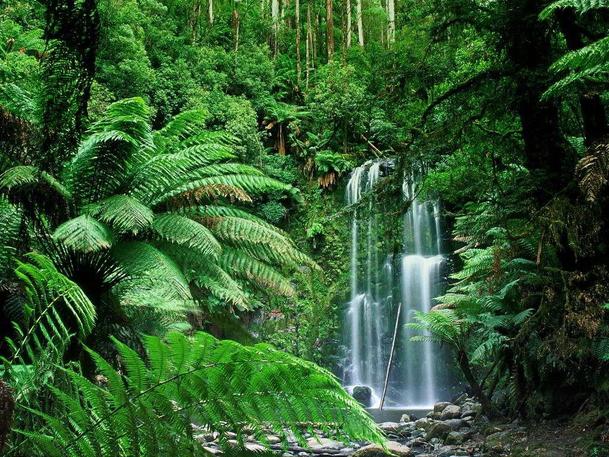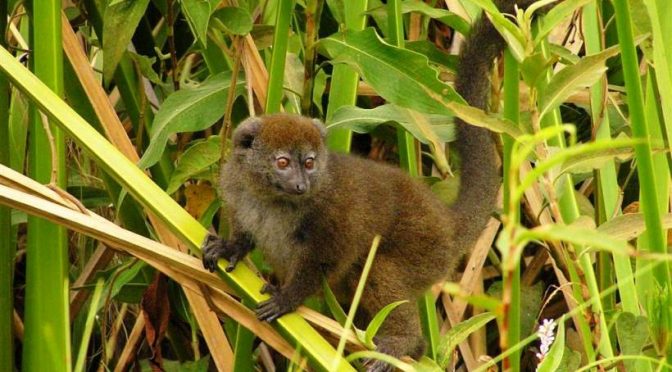The Alaotra - Mangoro area
(Lake Alaotra, Zahamena, Ambatodranzaka, Andasibe)
The Alaotra Rice Basin
The RN 44 and a railroad line connect Moramanga with the Alaotra Basin located 160 km to the north. This 1800 km² depression is formed by the Lake Alaotra, the largest lake in Madagascar, washed around. The domestication of the waters of this 182 km² "great sea" has made the region one of the largest rice granaries of the island.

Seventy-four species of birds nest on this lake, which is protected as a biological reserve. Two of them, the Aythya innotata and the Delacour diver (Tachybaptus rufolavatus), would only breed there.
The Sihanaka tribe
The Sihanaka tribe ("those of the lake") have long pursued a policy of raiding at the expense of their neighbors - the Betsimisaraka in the east, the Sakalava in the west and the Merina in the south - practiced before being pushed back to the shores of Lake Alaotra by Andrianampoinimerina in the early nineteenth century.
The Alaotra Basin, long devoted to irrigated rice cultivation, experienced a considerable boom with the construction of the railroad in 1922 and massive immigration from Reunion settlers in the 1950s.
The Zahamena National Park
The Zahamena National Park is a national park in Madagascar, located 50 km northwest of the city of Toamasina, near the Alaotra Lake, in the regions of Alaotra Mangoro and Analanjirofo lies.

The Zahamena Protected Areas Complex covers 64,370 ha, of which 42,300 ha for the National Park and 22,100 ha for the Reserve. A large part of the integral nature reserve is the central core of the protected area complex.
It is intended only for conservation purposes, so tourists do not have access.
The park is home to 112 species of birds, 62 species of amphibians, 29 species of fish, 46 species of reptiles and 48 species of mammals, including 13 species of lemurs.
In Zahamena, 151 species of pteridophytes, 60 species of orchids, 22 species of palms, 10 species of pandanus and 511 species of woody plants are known. Inventories of woody plants conducted since 1995 show an average of 1,450 trees per hectare with a canopy 20 m high.
The park can be reached via the national road 2 Antananarivo - Toamasina. In Moramanga, one must then turn onto RN 44, a secondary road, in the direction of Ambatondrazaka until the village of Antanandava.
From there it is necessary to drive a difficult track of 8 km to the entrance of the park in Ankosy, this track is only passable in the dry season.
In Antanandava there is a park office that organizes guided tours.
Bandro Camp at Alaotra Lake
This on the outskirts of the village Andreba located on the shores of Lake Alaotra, community-based tourism project has been Madagascar Wildlife Conservation (MWC) Association initiated.

Proposed Activities.
Canoeing at dawn with local MWC guides in the marshes of Lake Alaotra. A discovery along the water where you may see an endemic lemur species called Bandro Lemur (Hapalemur alaotrensis).
The guides will suggest further excursions around the lake to discover the fauna (very rich avifauna around the lake) and the local flora.
The best time to observe the fauna is from December to April, at dusk and sunset, when the animals are most active.
In order to minimize the negative impact on the ecosystem caused by a high influx of tourists, the MWK Association has established several rules: The traditional Sihanaka house can only accommodate 8 tourists, a maximum of 2 pirogues with a total of 4 tourists are allowed for excursions, excursions are limited in time so as not to disturb wildlife in their natural habitat.
Camp Bandro is managed entirely by the local members of the association.
Tourists are welcomed by the association MWC Andreba received exclusively by members of the local community.
The profits from ecotourism are used to finance microprojects within the village (drinking water, public toilets...).
The Andasibe-Mantadia National Park
The Andasibe-Mantadia National Park is part of the Toamasina province in the Alaotra-Mangoro region. It is located 1.5 km from Andasibe, 140 km from Antananarivo and 200 km from Tamatave.

The park consists of 80% of primary forest and 13% of secondary forest exposed to the impacts of human activities.
The special reserve is dedicated to the protection of the largest Malagasy lemur: the Indri indri. An orchid park is also open to the public.
In this dense forest, large species of biodiversity are protected, such as very rare endemic species and endangered species. 77% of flora, more than 80% of fauna and 58% of birds are endemic.
The national park is home to 108 species of birds, 72 species of mammals, including 14 species of lemurs, 51 species of reptiles, 84 species of amphibians and 350 species of insects.
The endemicity rate is about 82 percent.
However, this ecosystem is threatened by bushfires and slash-and-burn agriculture, illegal logging, poaching, and the collection of protected plants.
This situation can be explained in part by the demographic and social pressures seen in one of the poorest countries in the world.
















